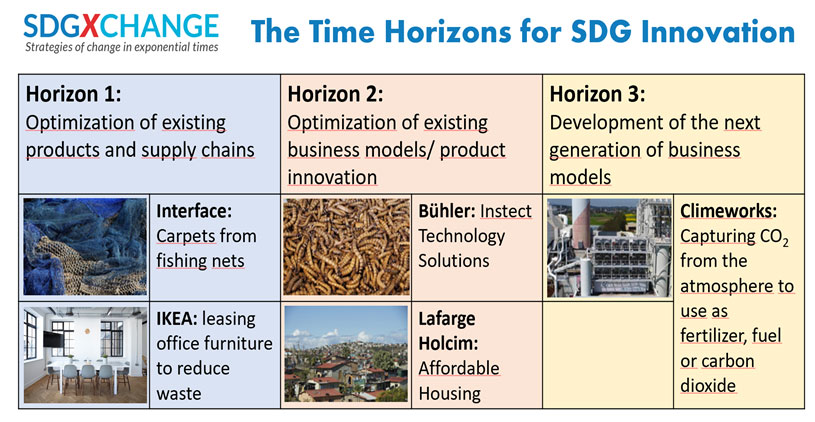Thinking in different innovation horizons How to secure the existing business without missing out on future opportunities

There is not a day the pressure of making the numbers isn’t present. Each day sometimes feels like an endless fight. Customers have growing needs and no sooner than these are met, new needs emerge. Securing the existing business seems like a relentless race against time and ever-present competitors.
In addition to taking care of the core business, a leader is on the constant look-out for the next big opportunity, either in related markets or in new geographic regions. There are new players coming up out of nowhere with solutions that may suddenly become a potential thread to the continued business. And there are developments out there that could benefit from the knowhow your business has. But these are more distant potential that instant revenue generators.
Studying pioneering companies has provided a clear insight in how they succeed. They carefully differentiate between different types of innovations for different types of time horizons, including:
Horizon 1 innovations
Innovating for the Horizon 1 is a natural extension of the ongoing, continuous improvement processes that any business is familiar with. Innovations are inspired from emerging new technologies that suddenly give the existing offering a new flavor, touching a nerve of a new promising customer group. It also involves looking at the supply chains and ensuring it not only meet but easily exceeds current standards particularly those with reputational risk potential.
A good example for such Horizon 1 innovations is the company Interface. The company noticed the growing attention of plastic waste and ocean pollution and wondered how it could contribute to solving this issue. It started testing if it can use old fishing net as a source material for its carpets, and soon was able to offer an environmentally conscious new product that appealed to a growing customer segment.
Another example is IKEA which wanted to access the business furniture market with its existing product offering, yet was facing pressure to close the loop in terms of material use. The company worked with a student consulting group using the SDGXCHANGE innovation process and developed a furniture leasing model for a new office furniture, first in Switzerland and soon globally.
Horizon 2 innovations
Optimizing the business model rather than only underlying products brings new challenges to the innovation process. Often the solution will serve a new customer or client basis, which in turn needs to be served differently than existing customers. This may require a new sales approach beyond the company’s existing sales channels. As a result, a new division may need to be created to launch such a new innovation.
Bühler, the Swiss industrial company, provides a good example here. Understanding the growing need for alternatives protein solutions, the company started to explore insect-based technology to offer new protein sources for existing and new clients. A move that shall protect its revenue growth even if some older products may be phased out over time.
When a SDGXCHANGE consulting team helped LafargeHolcim identify new business opportunities in the developing market Ecuador, they soon identified a huge social problem as a great opportunity. Affordable housing was seen as a massive challenge and LafargeHolcim engaged in developing an alternative to concrete based on existing waste products reducing the cost per ton significantly.
Horizon 3 innovations
Innovations for the Horizon 3 are best conducted in separate organizations and treated as a start-up. Developing prototypes for the next generation of business models requires a different frame of mind and a different organizational set-up, such as agile work or self-organization. Initially, such innovations need to be protected from standard performance measures, they need first to develop into full-grown workable solutions. Their implementation will often result in the creation of a new company and very likely be a collaboration with new partners outside the existing business.
While Climeworks is now run a single-standing start-up, it was born out of a few stakeholders trying to figure out how to capture CO2 from the atmosphere. Once they had explored a solution, a new company was created, funds were raised, and all those partner organizations with a strategic connection to the project joined as co-funders or investors in one way or the other.
There are three considerations to decide how to innovate for Horizons 1, 2 or 3. While large organizations often engage in all three of these at the same time, my advice would be that you start by listing all your ongoing innovations and by placing them into one of the three Horizons. You may notice that all of them fall into only one category. Only rarely will a company cover all three of them.
Secondly, I would suggest that you assess together with your team where your company stands in its current practice of considering so-called “outside-in” business opportunities. Those, that derive from social or environmental challenges that remain unresolved, such as the CO2 emmissions that inspired the ClimeWorks business model. Your company may have looked at world so far mostly with an “inside-out” perspective and have little practice in innovating otherwise.
Thirdly, it is sensible to assess your company’s change readiness. Use our free online tool to assess your current company culture as compared to the culture you would like. Do it with a few colleagues and you have an excellent basis for discussion about how flexible and how externally open your company is or should be.
Once you have understood if you should prioritize Horizon 1, 2 or 3 as your immediate next innovation project, it is time to put together your innovation process. For this, I suggest that you refer to the nine building blocks outlined in “Five Superpowers for Co-Creators” and select those steps relevant to you. If you prefer a ready-made version for business, the SDGXCHANGE is your perfect tool.
Lessons learned by the pioneering companies we have studied highlight three remaining considerations to keep in mind as you introduce your new innovation process:
- Develop appropriate performance measures for your innovation process: just because it doesn’t meet standard requirements doesn’t mean progress should not be measured
- Communicate your innovation vision: don’t assume others understand where you are going with your idea – explain them why you do what you want to do – both internally to your employees and externally to potential stakeholders with whom you want to work
- Identify allies: so that you have a sounding board when the going gets rough. Innovating for the unknown future is an adventure one should not go alone!
References:
The ready-to-use SDGXCHANGE business strategy tool: www.SDGx.org
The building blocks of Horizon 1, 2 and 3 innovations: www.5Superpowers.org
The outside-in perspective tester (true business sustainability): https://assessment.sdgx.org/index.php?r=survey/index&sid=65264&newtest=Y&lang=en
The change-readiness online test: |https://assessment.sdgx.org/index.php?r=survey/index&sid=414663&newtest=Y&lang=en
Have you read?
Countries With The Highest Inflation Rates In The World.
Best Countries For Investment In Travel And Tourism Sector.
Best Private Jets For CEOs And Business Leaders.
India Rich List Index: Richest Indian Billionaires.
Best Leisure Destinations To Visit In 2020.
Bring the best of the CEOWORLD magazine's global journalism to audiences in the United States and around the world. - Add CEOWORLD magazine to your Google News feed.
Follow CEOWORLD magazine headlines on: Google News, LinkedIn, Twitter, and Facebook.
Copyright 2025 The CEOWORLD magazine. All rights reserved. This material (and any extract from it) must not be copied, redistributed or placed on any website, without CEOWORLD magazine' prior written consent. For media queries, please contact: info@ceoworld.biz









